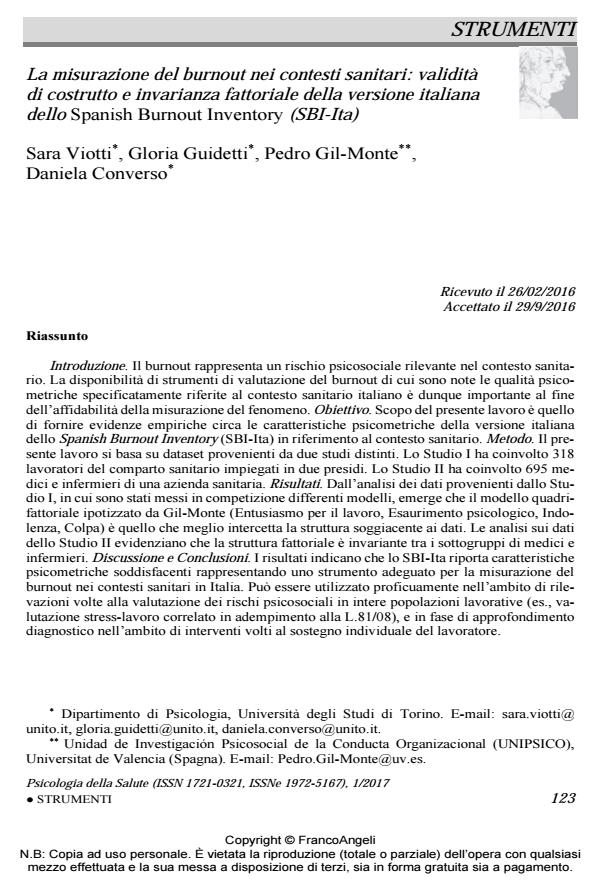Measuring burnout among health-care workers: construct validity and factorial invariance of the Italian version of the Spanish Burnout Inventory (SBI-Ita)
Journal title PSICOLOGIA DELLA SALUTE
Author/s Sara Viotti, Gloria Guidetti, Pedro Gil-Monte, Daniela Converso
Publishing Year 2017 Issue 2017/1
Language Italian Pages 22 P. 123-144 File size 299 KB
DOI 10.3280/PDS2017-001007
DOI is like a bar code for intellectual property: to have more infomation
click here
Below, you can see the article first page
If you want to buy this article in PDF format, you can do it, following the instructions to buy download credits

FrancoAngeli is member of Publishers International Linking Association, Inc (PILA), a not-for-profit association which run the CrossRef service enabling links to and from online scholarly content.
Background. Burnout is an important risk among healthcare workers. Therefore, the availability of reliable and valid instruments to measure burnout is crucial in helping healthcare management to determine the dimension of the problem inside an organization and to prevent it and its consequences through appropriate intervention programs. Aim. The purpose of the present study was to provide empirical evidence as regards the psychometric properties of the Spanish Burnout Inventory (SBI-Ita) among Italian healthcare workers. Method. Data were collected in two different studies. Study I involved 318 healthcare workers, including various occupations. Dataset from Study II consisted of 695 workers (nurses=453; physicians=242). Results. The analyses on the dataset from Study I, based on the comparisons of models including various numbers of factors, indicated the best fit to the data was reported by the four-factor structure hypothesized by Gil-Monte (Enthusiasm towards the job, Psychological exhaustion, Indolence, Guilt). The analyses on the dataset from Study II highlighted that the factorial structure was invariant across nurses and physicians (scalar invariance). Discussion and Conclusions. This study provides evidence for the adequate psychometric properties of SBI-Ita among healthcare workers. An Italian version of SBI may offer to occupational health practitioners an expanded conceptualization of this syndrome, and can be employed to assess burnout both in a psychosocial and in a clinical perspective. .
Keywords: Spanish Burnout Inventory, physicians, nurses, Confirmatory Factor Analyses, Factorial Invariance
- Work Satisfaction and Its Relationship with Burnout and Its Consequences, Using a Structural Model, in Air Cabin Crew Members Dáilet Fredes-Collarte, Víctor Olivares-Faúndez, José Carlos Sánchez-García, Jenniffer Peralta Montecinos, in Sustainability /2024 pp.9619
DOI: 10.3390/su16229619 - Feeling Guilty or Not Guilty. Identifying Burnout Profiles among Italian Teachers Gloria Guidetti, Sara Viotti, Pedro R. Gil-Monte, Daniela Converso, in Current Psychology /2018 pp.769
DOI: 10.1007/s12144-016-9556-6 - We cannot be “forever young,” but our children are: A multilevel intervention to sustain nursery school teachers’ resources and well-being during their long work life cycle Ilaria Sottimano, Gloria Guidetti, Daniela Converso, Sara Viotti, Leonidas G Koniaris, in PLOS ONE /2018 pp.e0206627
DOI: 10.1371/journal.pone.0206627 - I’ll Be a Caregiver-Employee: Aging of the Workforce and Family-to-Work Conflicts Daniela Converso, Ilaria Sottimano, Sara Viotti, Gloria Guidetti, in Frontiers in Psychology 246/2020
DOI: 10.3389/fpsyg.2020.00246 - When social support by patrons protects against burnout: A study among Italian public library workers Mara Martini, Sara Viotti, Daniela Converso, Jolanda Battaglia, Barbara Loera, in Journal of Librarianship and Information Science /2019 pp.1091
DOI: 10.1177/0961000618763716 - Psychometric Properties of the Spanish Burnout Inventory in University Teachers in Hybrid Education Angel Deroncele-Acosta, Pedro R. Gil-Monte, Roger P. Norabuena-Figueroa, Pedro Gil-LaOrden, in Chronic Stress 24705470231214950/2023
DOI: 10.1177/24705470231214950
Sara Viotti, Gloria Guidetti, Pedro Gil-Monte, Daniela Converso, La misurazione del burnout nei contesti sanitari: validità di costrutto e invarianza fattoriale della versione italiana dello Spanish Burnout Inventory (SBI-Ita) in "PSICOLOGIA DELLA SALUTE" 1/2017, pp 123-144, DOI: 10.3280/PDS2017-001007